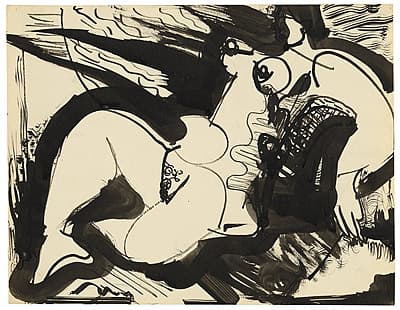
Hans
HOFMANN
Germany
1880
–
United States of America
1966
Reclining figure
1935
brush and India ink
no inscriptions
sheet
21.4 (h)
x 27.6 (w)
cm
Purchased 1980
National Gallery of Australia, Canberra
NGA 1980.3403
© Renate, Hans & Maria Hofmann Trust/ARS. Licensed by Viscopy
- estate of Hans Hofmann M-933/223;
- with André Emmerich Gallery, New York;
- from whom bought by the Australian National Gallery, November 1980
- Hans Hofmann Drawings: 1930-1944
- Andre Emmerich Gallery Inc 10 Dec 1977 – 11 Jan 1978
- Drawing explorations, 1930û1978
- Janus Gallery 10 Dec 1977 – 11 Jan 1978
- Abstract Expressionism: the National Gallery of Australia celebrates the centenaries of Jackson Pollock and Morris Louis
- 14 Jul 2012 – 24 Feb 2013
- Hans Hofmann drawings 1930–1944, New York: André Emmerich Gallery 1977, illus. b&w p. [25]
Hans Hofmann was a strong influence on many American Abstract Expressionist artists, as a teacher and, especially, as a draughtsman; his own practice as an oil painter manifested itself later in his career. His firsthand knowledge and experience of French and German avant-garde art included the emergent Cubism and Fauvism in Europe, and he knew the major protagonists.
Two drawings from 1935 show Hofmann’s adoption of elements of these styles. The dynamic diagonals of Seated female nude contrast with rhythmic curves in Reclining female nude: we see remnants of Picasso and Braque’s angular Cubism versus Matisse’s expressive Fauvism. Eight years later, his Seated female figure 1943 shows Hofmann’s evolution, and mature synthesis of both approaches.
Hofmann spent his first decades in the United States practising and teaching drawing, and his fluency increased during this time. Using brush and ink allowed freedoms such as the dramatic outlining of forms, as well as larger movements of the artist’s hand and arm over the sheet. Close observation of the model’s body was transformed into more complex aesthetic choices. As Hofmann became a most important influence on the development of Abstract Expressionism, the increasing abstraction of nature was more evident as American artists liberate themselves from the European tradition.
Christine Dixon
The National Gallery of Australia holds one painting and five drawings by Hofmann: two female nudes of 1935, a self-portrait c. 1932–35, all brush and ink; and two untitled drawings of 1943, brush and ink, one with watercolour and charcoal.
